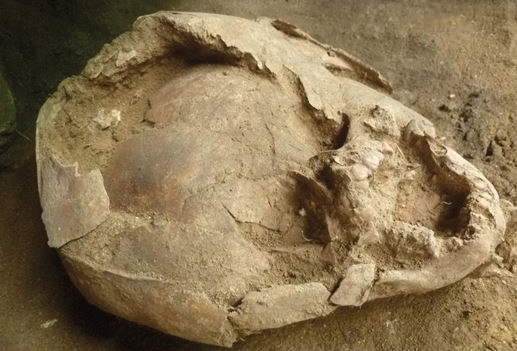Protecting the Young
March/April 2020
 The remains of infants buried wearing the craniums of older children as helmets have been excavated at the site of a ritual and funerary complex belonging to the pre-Columbian Guangala culture of coastal Ecuador. The burials are believed to date to around the first century B.C. According to University of North Carolina at Charlotte archaeologist Sara Juengst, natural disasters in the ancient Andean world often prompted dramatic reactions, including the sacrifice of children. In this case, the infants may have been sacrificed in an attempt to end environmental degradation and drought resulting from a possible volcanic event attested to by ash discovered at the site. However, archaeologists also found lesions on the infants’ skeletons, suggesting they were in chronic poor health. “They may have died of illness,” Juengst says, “but I wondered about the children who provided the additional craniums.” She suggests that these older children may have undergone a ceremony to induct them into full personhood in Guangala culture before their death, while the infants had not. Juengst believes that the skulls of deceased older relatives may have been exhumed and placed on the heads of the infants to provide spiritual protection against whatever fate was believed to befall those who died before reaching this milestone.
The remains of infants buried wearing the craniums of older children as helmets have been excavated at the site of a ritual and funerary complex belonging to the pre-Columbian Guangala culture of coastal Ecuador. The burials are believed to date to around the first century B.C. According to University of North Carolina at Charlotte archaeologist Sara Juengst, natural disasters in the ancient Andean world often prompted dramatic reactions, including the sacrifice of children. In this case, the infants may have been sacrificed in an attempt to end environmental degradation and drought resulting from a possible volcanic event attested to by ash discovered at the site. However, archaeologists also found lesions on the infants’ skeletons, suggesting they were in chronic poor health. “They may have died of illness,” Juengst says, “but I wondered about the children who provided the additional craniums.” She suggests that these older children may have undergone a ceremony to induct them into full personhood in Guangala culture before their death, while the infants had not. Juengst believes that the skulls of deceased older relatives may have been exhumed and placed on the heads of the infants to provide spiritual protection against whatever fate was believed to befall those who died before reaching this milestone.